
This post may contain affiliate links. Click here to find out more about this.
Table of Contents
Basic SEO Strategies by Optimizing Voice Search is one of the most critical topics in the search industry though it may state as a small concept. Starting with smartphones then quickly escalated to smart speakers and voice assistants worldwide. Learn the Basic SEO Strategies by Optimizing Voice Search.
It has gained mileage because it is more convenient for a user to speak with an assistant than to type. The results of voice queries are also faster.
Here are a few statistics to prove that voice search is here to stay:
Teenagers are savvy users of voice search, but Thrive Analytics found that people in all age groups use mobile personal assistants.
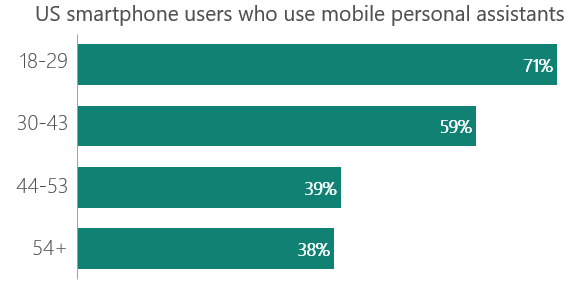
When and where are these people using voice search?
They use it on the go, with friends, and even in the bathroom.
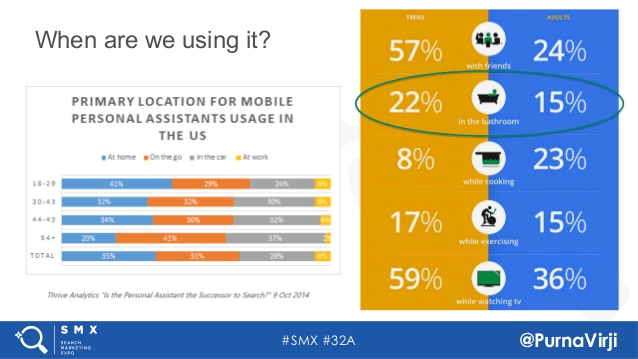
With the increased use of digital assistants, voice search optimization is critical to your SEO success.
This article will show you how to optimize your content and website for this search trend. Let’s begin by understanding how it ties back to Google’s algorithm.
The Hummingbird update
In 2013, Google launched a major algorithmic update — the Google Hummingbird. It started considering the user intent and contextual meaning of queries.
Marketers had to refine their strategy. They went from stuffing keywords in articles to addressing the pain points of their target audience.
Voice technology is another step toward improving the user experience with semantics.
Natural Language Processing (NLP) relies on recognizing voice texture, interests, and behavior.
Subscribe to our monthly newsletter filled with good stuff
Your data are safe with us. We will never spam and you can always unsubscribe with 1 click.

With time, Google “learns” your language, accent, and other patterns in the way you speak.
Now, it focuses on the semantics and the broader contextual relevance of the user’s query.
Let us test Google’s semantic capabilities with a few voice searches on its app on iPhone 6s.
Let’s start with a search for comedian and actor T.J. Miller.

Now, let’s find out if Google can use this initial search query to maintain context.
We asked the name of T.J. Miller’s character on the TV show “Silicon Valley.”
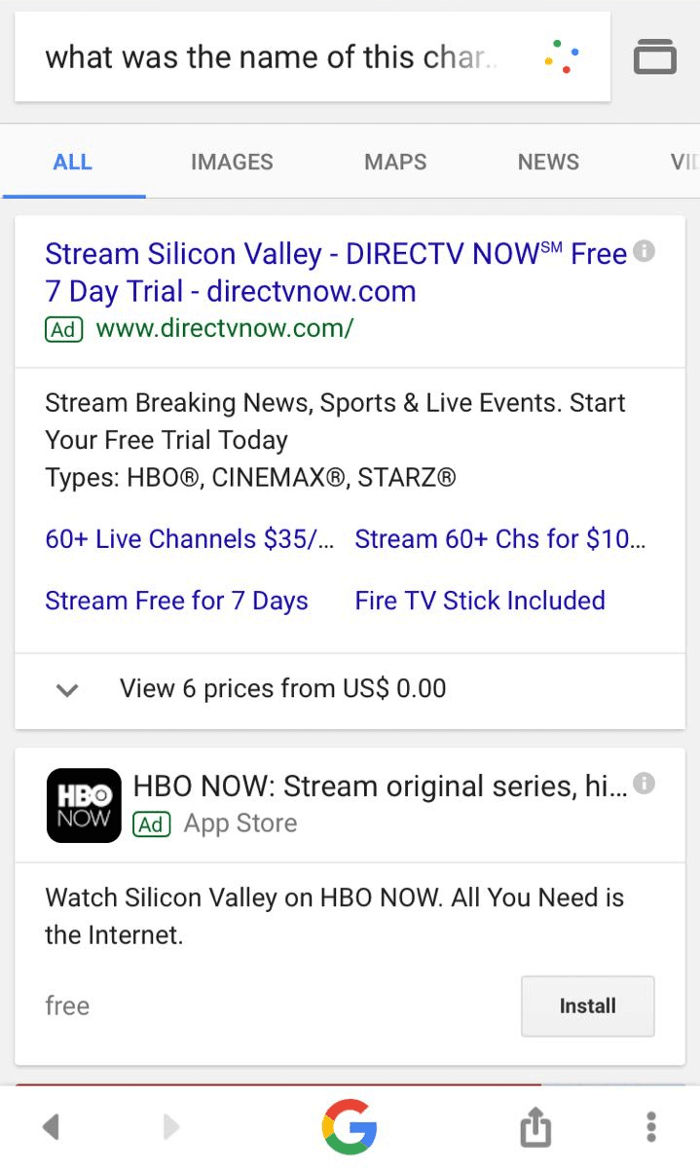
As you can see from the screenshot, Google returns an ad by DIRECTV NOW and a link to the HBO NOW app.
Let’s not call that a good user experience — the question asked was specific and related to the first query.
When you scroll below the fold, a snippet appears that shows the names of all the characters on the show.

It seems like Google still has to cover the ground with fictional characters.
As Google continues improving its algorithm, we can expect the user experience to become more intuitive and smooth.
Three characteristics of voice search
When we use a computer, we use short phrases to find information because it saves physical effort.
1. Voice queries contain conversational words and are longer.
On mobile, the searches are a conversation with a virtual assistant.
Artificial intelligence powers voice search engines and becomes smarter with every conversation.
When you search for restaurants via typing on your phone or computer, you might write “best restaurants in San Diego.” This is a computer language.
If you use voice search, you will probably ask a question, like “Which restaurant serves dinner now?”
Both the above queries contain five words. Purna Virji found that speech searches tend to be longer through the tail.
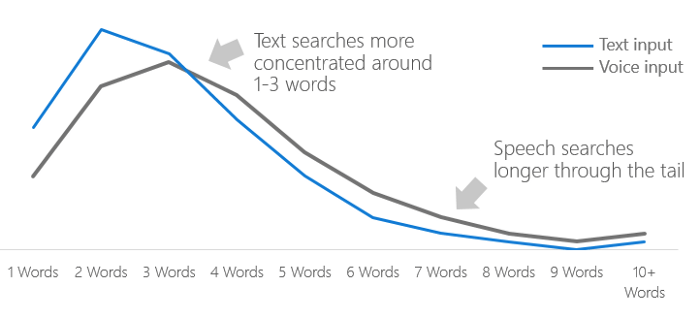
Don’t mistake equating voice search optimization to using long-tail keywords in your content. Voice search is more likely to contain question phrases.
Keyword research tools generally won’t find phrases people speak using mobile assistants.
Such phrases have also seen growth year on year.
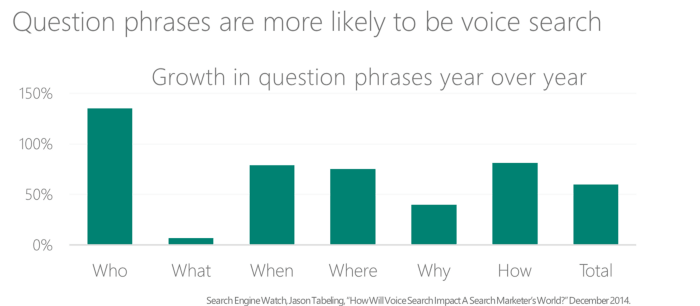
As mentioned, most long-tail keyword tools will return text-based queries. They will pull LSI keywords and alphabetical variations.
How can you leverage this characteristic?
From the Basic SEO Strategies by Optimizing Voice Search, starting your research with a tool called Answer the Public is recommended.
When you enter a keyword, it returns a bunch of questions.
Here are the results for the keyword’ flights.’

These natural language phrases are full of insights. You can get an idea of the consumer’s mindset and tie it back to your marketing funnel.
Other tools you might want to check out for picking natural language phrases are Question Samurai and StoryBase.
You can interpret a user’s intent based on the kind of question phrase they use.
‘What’ and ‘Who’ questions signal that a user is in the research phase. If they are asking ‘Where’ questions, they are almost ready to buy.
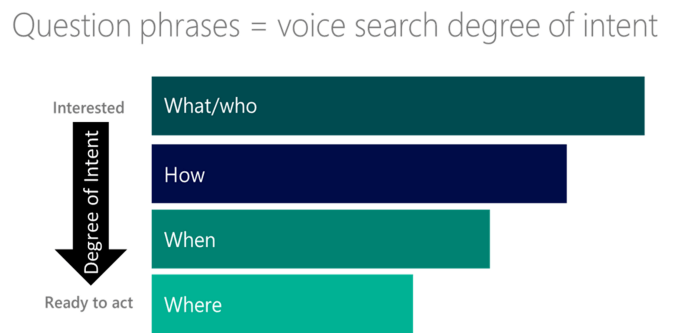
Do you want another strategy to find the questions your customers use?
Log in to your Google Analytics account and check out the keywords people use to find your content.
Soon, you can expect separate voice search reporting in your analytics report.
The Internet Trends Report 2016 found that 22% of people use voice search for finding local information. It makes sense because people use mobile phones on the go.
2. 22% of voice queries are for local content.
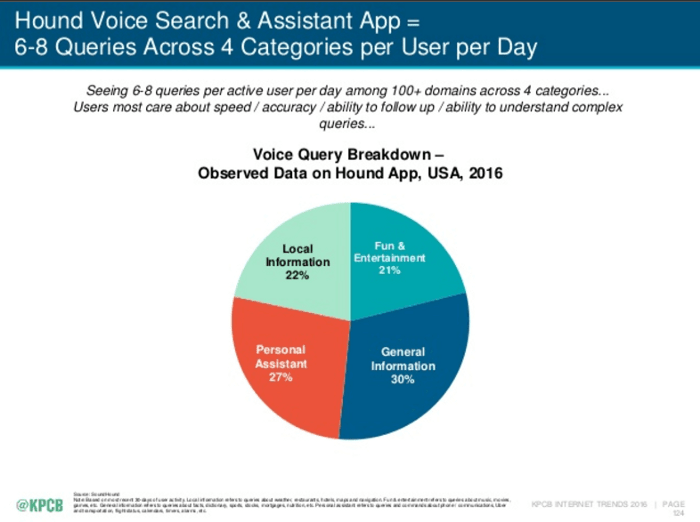
Google disclosed that “near me” searches have grown more than 130% YoY. People extensively use the search query for “things to do near me.”
Needless to say, it is a mobile-driven phenomenon. Voice search makes these “near me” searches faster and easier for the user.
Did you know that 50% of local mobile searches by a consumer lead to a store visit in a day?
How can you leverage this characteristic?
Given that users have local intent when searching on their mobile phones, you need to get the keywords right.
You can gain a lot more business by carefully incorporating the following keywords into your SEO strategy:
- The phrases people use to describe the neighborhood around your location
- “Near me” in your title tags, meta description, internal links, and anchor text
- Landmarks around your business location
- The titles of local institutions that are relevant to your business
The top use of voice queries remains rooted in personal assistance. Both teens and adults mainly use voice search for making calls and asking for directions.
3. Users want immediate results.
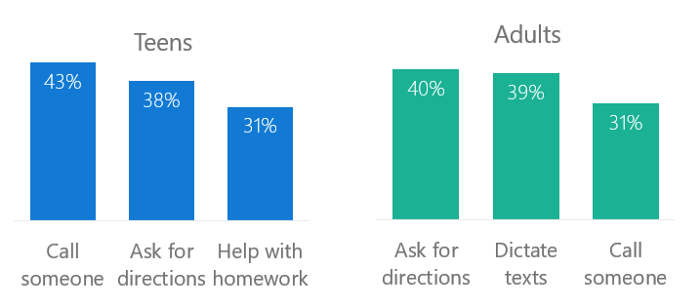
Even when finding general and local information, don’t expect users to visit your website.
They have a clear intent when looking for services from a local business.
Suppose a user wants a haircut. He performs a voice search for salons.
Google returns the nearest salons with their addresses, distance from the user’s location, timings, and reviews.
Based on the ratings and their preferences, the user can choose a salon and directly click on the “Call” button to book an appointment.
Ideally, your relevant content should appear as a snippet above the fold.
Your business listing should have a good number of positive reviews. Also, update your office hours, contact details, physical address, and the like.
How can you leverage this characteristic?
We will discuss optimizing your business listing in more detail later.
There’s no guaranteed way of getting your page as a featured snippet.
Still, you should attempt to get a berth at the coveted #0 spot by answering your user’s questions.
With the above characteristics in mind, let’s start with the first Basic SEO Strategies by Optimizing Voice Search.
Strategy #1: Use structured data
Search engines also look at many factors besides content to determine a page’s relevance and position in their search results.
Professional SEOs leverage these additional factors to optimize their content for search engines further.
Schema markup, also known as structured data, is one such factor. It does not affect the rankings directly, but it can give you an edge over your competitors.
The visitors do not see it, but microdata helps search engines to organize and classify your content. It is an underutilized strategy because it requires work.
The following markup classifies your contact details page as containing contact information.

You can also use schema to enable search enhancements and get visually appealing results on the search engine results page (SERP).
For example, look below at the recipe page result with star ratings, details about the number of calories, and cooking time.

Here’s the structured data that labels every ingredient in the recipe.

Now, let me guess your next question: How is microdata relevant to voice search?
When users search for local businesses, they often look for operational hours, contact information, address, highway directions, and the like.
You can use microdata to ensure that search engines classify this information.
Let’s search for the population of Dubai.

Because of a markup, Google quickly retrieved the figure from the World Bank website.
Additionally, it is recommended that you submit a detailed sitemap to Google.
Lastly, ensure that your structured data pages are not blocked using robots.txt and other control methods.
Businesses can experience a drop in traffic and disappearance from rankings due to a minor change in the robots.txt directives.
We can cover you here if you want a step-by-step guide on implementing schema markup. You can test your structured data using the Structured Data Testing Tool.
Strategy #2: Claim your Google My Business listing
As we saw earlier, the voice search considers a high number of hyper-local queries.
Want an easy way to help your customers find you?
Share your business information in your site’s footer in a simple text format.
That is where users are accustomed to seeing it.
Salon California does an excellent job on its website by sharing relevant information in its site’s footer.
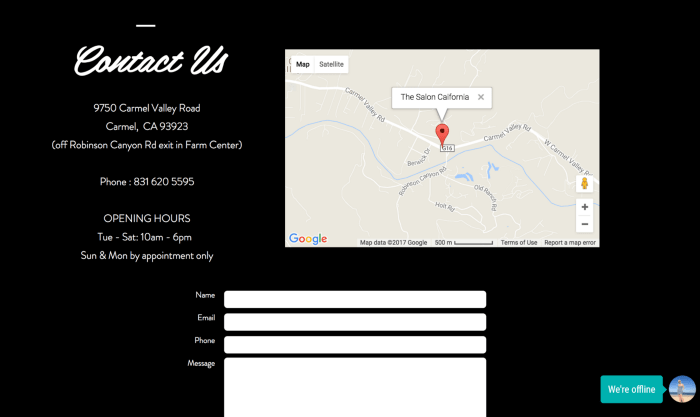
There are two ways in which a user might search for local businesses.
1. “Pizza delivery in Detroit” — If you have optimized your site for local keywords, you have a chance to appear higher in search results.
2. “Pizza delivery near me” — For such questions, Google relies on the user’s location and turns toward Google My Business listings.
That is why it is vital to claim your Google My Business listing.
Ensure that your name, address, and phone number (NAP) are accurate in the listing.
The phone number should ideally contain the area code. Further, I recommend using your business domain for your Google My Business login instead of a free Gmail account.
The introduction field is your business pitch. You should beef it up with about 400 words to describe your products and services.
It is also essential to associate your listing with relevant categories. Google wants you to use categories to “describe what your business is.”
Here are three examples to help you differentiate between correct and incorrect categories.

Choosing the right category is essential. It can mean the difference between appearing at the top vs. disappearing from the voice search results.
You need to stay consistent if you are filling out your NAP information in other business directories.
Even slight differences in your address or other business information can damage your local SEO.
If you want more detailed local SEO instructions, then check out my guide.
Strategy #3: Get mobile-friendly
Another Basic SEO Strategies by Optimizing Voice Search. Voice search mainly happens on mobile devices. Your site has to be mobile-friendly.
Google recommends a responsive web design. Most WordPress themes are inherently so.
Want to test if your website complies with Google’s guidelines?
You can use Google’s Mobile-Friendly Test Tool.
If everything is fine, you will get a message that says, “Page is mobile-friendly.”

On the other hand, if your website needs to be fixed, then Google will indicate the specific steps you need to take.
You are not done yet.
Your site also needs to load fast. With our short attention spans, it must not be surprising that we expect websites to load instantly.
You can plug your site into PageSpeed Insights to gather details on your load speed.
If you want to find out what specific elements are slowing down your site, plug it into Webpagetest.org.
You will get a content breakdown and a waterfall graph showing how each element affects your loading time.
Here are the results.

Once you have fixed your design and speed, move on to the content.
You might remember that people read in an F-shaped pattern on desktops.
On mobile, the story is different. The German Research Center for Artificial Intelligence recorded reading interaction as below.

There were three broad categories of readers, and they switched their reading patterns.
SensoMotoric Instruments conducted a study on iPhone reading. They found that just 5% of people read the text.

Our reading habits rapidly evolve on mobile, but we know that the content needs optimizing to aid scannability.
You need to leave many white spaces, use short sentences, and choose simple words, small paragraphs, and engaging sub-headings.
This post sheds light on the topic in detail.
Strategy #4: Create blog posts answering your customers’ questions
People speak different keywords than the ones they type in search engines to refer to your products, services, and business.
For example, a user might type “salon near me,” but using voice search, they would say, “what is the nearest salon near me.”
You must listen carefully to the words people use when talking about you.
Once you have collected their common questions and phrases, you can create content for them.
Most companies limit these efforts to a single FAQ page. But it is recommendable that you create dedicated blog posts based on your customers’ questions.
You can also optimize the existing content on your blog and product pages for these queries.
It is also profitable. River Pools and Spas started following this strategy. They responded to questions from their audience on fiberglass pools.
As a result of content marketing, they saved the company after three consecutive weeks of overdrawing their bank account.
The owner, Marcus, shared that a single blog post helped him generate more than 2 million sales.
The blog post answered a question he repeatedly heard from his customers, “How much does a fiberglass pool cost?”

If you are unaware of how your customers describe your product, you might be missing critical business insights.
Let me share another example.
Subscribe to our monthly newsletter filled with good stuff
Your data are safe with us. We will never spam and you can always unsubscribe with 1 click.
Airbnb created the perfect experience for its customers by doing things that don’t scale.
The founders turned around the company’s growth slump by traveling and staying with their hosts. They found insights to create a world-class product for their customers.
Conclusion
The future of voice search is not predictable. However, we know it is gaining considerable traction, and its growth is not slowing anytime soon.
That’s both good and bad for marketers.
It’s suitable for marketers who understand the power of voice search and start optimizing their content for it.
It’s bad for marketers who ignore the trend and continue creating the same old content.
You must return to the drawing board and modify your SEO strategy to incorporate voice optimization.
It is hard work, but voice search optimization makes your content closer to human language.
Now is the perfect time to jump on the voice SEO ship and gain an edge over your competition. Basic SEO Strategies by Optimizing Voice Search





